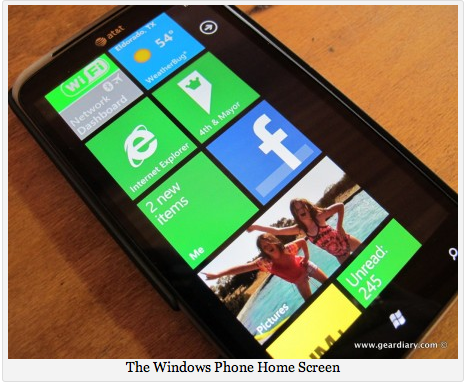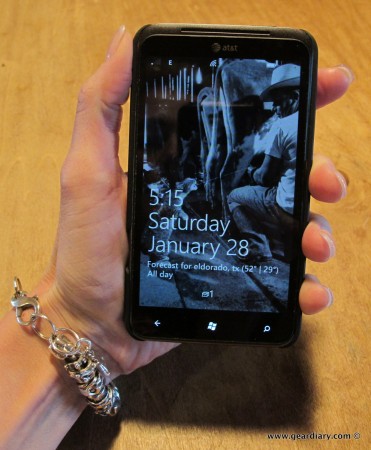
Judie: I recently reviewed the Nokia Lumia 710; even though the lower-end phone’s hardware wasn’t the greatest, I came away with a new respect for the Windows Phone operating system. About a week later, Dan and I were at a Microsoft-sponsored CES dinner where we were both given an HTC Titan to try. Maybe it’s because at 4.7″ the Titan’s screen was so amazingly large when I laid it to my iPhone with its 4S 3.5″ screen, maybe it’s because I was at CES and had been looking at new phones for days, or maybe it’s because I was looking for an excuse to use something different from the iPhone OS which has basically become as comfortable — and dare I say unexciting — as an old shoe; I don’t know.
For whatever the reason, I was ready for a change.
That evening I came back to the hotel, and I slipped my iPhone 4S’s micro SIM into an adaptor tray that I just happened to have in my wallet. A couple of adjustments later, and the SIM was firmly seated, inserted, and the Titan was powered on.
My iPhone has not been used since.
Dan: I was perfectly happy, albeit a tad bored, with my iPhone. The arrival of Siri and iCloud made living in Apple’s walled garden a seamless experience and one I was happy to be part of. Then hell froze over. Carly got an iPhone and abandoned Android. Suddenly there were a few too many iPhone users here on the site. So I thought to myself, “Self, is there some other phone that might offer a similarly positive experience as the iPhone that would let me have the fun of exploring a new OS AND add some diversity to our dialogue?” I KNEW that Android would not be the answer to that. Been there. Done that. Not a fan.
But I had enjoyed my brief stint with Windows Phone (more on that in a bit) and, combined with awesome hardware it just might be the ticket.
Judie: Windows Phone is nothing like Windows CE, Pocket PC 2000, Pocket PC 2002, Pocket PC Phone, Windows Mobile (in all of its many version numbers), or any of the other names and iterations that Microsoft’s mobile devices have been known by; Windows Phone is a completely new animal. And yes, Microsoft messed up a bit when they originally released it as Windows Phone 7, but they seem to have figured out that simpler can sometimes be better and they have since dropped the 7.
So let me get to the point: if you are hanging on to bitterness at the Windows Mobile OS’s fragmented and ugly ecosystem, if you are allowing your aggravation for the money that you spent on the overpriced apps which ran on it from letting you try something new, if you are a developer who got sick of the way nothing wound up working together, or whatever the reason might be … try for a moment to just let it go.
Dan: I entered this with a huge bias against Microsoft’s mobile operating system and was dead wrong. Yeah, I needed to “let it go” and when I did… well my iPhone hasn’t been used since, either.
This Is a New Beginning
Judie: Windows Phone was built from the ground up to be intuitive, clean, and — even though offered on various hardware manufacturer’s devices — uniform. This would mean shutting down the openness and hackability that so many “power users” had previously enjoyed with the creation of a closed ecosystem and Microsoft-run marketplace employing a level of control only previously seen on iOS devices. This also meant demanding a uniform set of specifications from every Windows Phone manufacturer so that on even the least expensive phone the “experience” would be the same. Not to put too fine a point on it, this pissed a lot of power users off, and I think many of them have since moved to Android.
In late 2010, a collection of nine HTC, LG, Dell and Samsung Windows Phone 7 devices were offered for worldwide sale to a largely unimpressed and uncaring public. Bear in mind that many of these people were now firmly entrenched in the iPhone or Android camp. By many who tried it, including me, Windows Phone 7 was considered to be a better than average operating system, even if it wasn’t quite ready for prime time. Although I would typically play devil’s advocate and defend Windows Phone by saying things like, “well, when the iPhone was first released, it didn’t have cut & paste or any apps, either,” I was fairly disgusted with Microsoft for thinking they could get away with releasing what seemed like a half-finished (even if “pretty”) operating system. I bought a T-Mobile HTC HD7, used it, and then sent it to Dan after deciding there was no way that device or operating system could replace my iPhone.
When the Windows Phone 7.5, or “Mango”, update came out late last year, there were more improvements immediately evident than just the shortened name. Cut & paste had finally been added, and great strides had been made to make the phone more social and people-centric. Best of all, there were now many more apps in the Marketplace; developers seemed to finally be coming around. Windows Phones are offered by the original manufacturers who are all still adhering to a strict set of standards, and now Nokia has been added to the mix. The result of all of these experienced handset manufacturers creating their own handsets is that as a Windows Phone user you can experience an intuitive, fast, visually stunning, and nearly uncrashable use in a device that suits your needs and lifestyle.
This has resulted in a user-experience that is on par with, and possibly surpasses that of using an iPhone; it is an experience that leaves Android in the dust. And don’t worry; I have on my fire-retardent suit, so those of you who have tried Windows Phone and decided that you like another OS better may feel free to flame away in the comments … but I do ask that unless you have actually used a Windows Phone, you’ll hold your tongue until you can actually offer something to the conversation.
To give you a taste of the UI, I found this Mango overview video that gives a good representation of what you can expect to see …
Dan: Although this series of posts is really about the experience of two iOS users moving to a Windows Phone, at the same time, it would be impossible to speak about Windows Phone and NOT speak specifically about the hardware on the HTC Titan that both Judie and I are using. The reason for this is simple, and it is one of the ways in which Microsoft has set the stage to blow Android away. And as Judie wrote in the intro, those of you who disagree are welcome flame away! But that was not written lightly and I/we stand behind it!
In redesigning their mobile operating system from the ground up, Microsoft took the same route as Apple. They locked down the specs with regard to what hardware can run the OS. For Apple it was actually an easier move since they own and manufacture both the OS and the hardware. Despite the challenges and all the people who would get bent out of shape about it, Microsoft went this route even through they were not and are not a hardware manufacturer. The result is hardware that works seamlessly with the platform. This stands in direct opposition to Android, which is the equivalent of the mobile device ‘wild west’ with its multiple versions of hardware and every iteration of the OS from the first version floating around — because the manufacturer’s did not allow upgrade paths that the average consumer could utilize.
Judie: In our next installment, Dan and I will talk about the Titan’s Hardware, comparing it to the iPhone 4S that both of us emigrated from …

